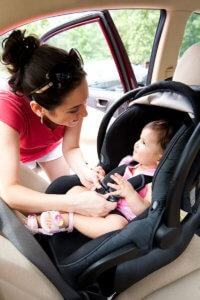 The number of people with a driver’s license in the United States grew from around 167 million in 1990 to approximately 222 million in 2016. Currently, women account for some 51 percent of licensed drivers in the U.S.* This means that 68% of Americans drive daily. Looking at this data we can see that unless you live in a heavily populated metropolitan area with easily accessed public transportation, you probably drive at least 3-4 times a week. With adding an infant to your daily routine, you’ll need to know the Do’s and Don’ts of traveling with your baby.
The number of people with a driver’s license in the United States grew from around 167 million in 1990 to approximately 222 million in 2016. Currently, women account for some 51 percent of licensed drivers in the U.S.* This means that 68% of Americans drive daily. Looking at this data we can see that unless you live in a heavily populated metropolitan area with easily accessed public transportation, you probably drive at least 3-4 times a week. With adding an infant to your daily routine, you’ll need to know the Do’s and Don’ts of traveling with your baby.
DO’s
- Always check the local rules for children positions in a car. The rules vary from one location to another. Local motor vehicle sites will be helpful.
- DO make sure your child is riding in the backseat. The backseat is generally the safest place in the vehicle children can ride. If your car has a passenger seat airbag, the backseat is 100% the safest spot in the car. Do you have a car where maybe there isn’t a backseat such as a pickup truck? Place the car seat on the passenger side and deactivate the airbags on that side. You can also install a power switch that will prevent airbag deployment in the event of an accident.
- DO consider the child’s weight before changing seats. As your child grows from infant to toddler you will eventually spin their seat around and have them forward facing as well as sitting up. As they continue to grow their full harness may seem restricting or over-protective and you may be tempted to move them to a booster seat too early. Car seat manufacturers recommend waiting until the child is at least 40 pounds in weight before taking them out of a full harness seat. Once they have reached that weight “a belt-positioning booster seat, used with the adult lap and shoulder belt, is preferred for children weighing 40 to 80 pounds.” *
- Always check to see that the car seat is currently safe. Check to see that the car seat is not subject to a manufacturer’s recall, ensure the date has expired and that the car seat has not been in an accident.
- DO read the instruction manual thoroughly before and after installing the car seat. Your car seat will come with a set of instructions for installation as well as your vehicles owner’s manual. Read both sections in full to ensure proper installation of the car seat. “Make sure the seat is tightly secured, allowing no more than 1 inch of movement from side to side or front to back when grasped at the bottom near the attachment points and facing the correct direction.” * Angle is also very important as infant need to be reclined while riding in a seat, so their airway remains open and their head doesn’t fall forward. Your instruction manual should provide you with a correct angle based on the size or age of the infant.
DON’Ts
- DON’T forget to remove heavy outerwear before strapping the infant in. “Bulky outerwear and blankets can prevent harness straps from snugly securing your baby. Buckle the harness, and then place a coat or blanket over the harness to keep your baby warm.” *
- DON’T keep your child in their car seat for longer than necessary. “A car seat is designed to protect your child during travel. It’s not for use as a general seat or replacement crib in your home. Sitting in a car seat for lengthy periods poses health risks. It can affect your child’s ability to breathe, contribute to the development of a flat spot on the back of your baby’s head and worsen gastroesophageal reflux disease (GERD) — a chronic digestive disease. In addition, a child can easily be injured by falling out of an improperly used car seat or while sitting in a car seat that falls from a table.” *
- DON’T start driving before checking all safety belts for snugness and security. “Keep the straps over your child’s shoulder. The harness should be adjusted so you can slip only one finger underneath the straps at your child’s chest. Place the chest clip at armpit level.” *
For more safety tips and in-depth ways to securely travel with children see the following websites and always remember to reference the owner’s manual for your specific equipment:
Source: www.parents.com www.mayoclinic.org
